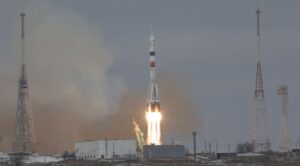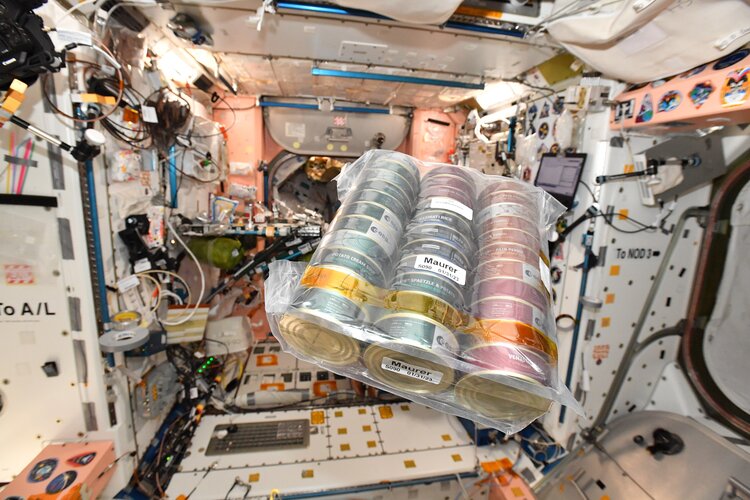Soyuz launches Japanese private astronauts to ISS
Wednesday, 08 December 2021 11:34
A Soyuz spacecraft launched Dec. 8 carrying two Japanese private astronauts and a Roscosmos cosmonaut on the first flight in more than a decade for space tourism company Space Adventures.
Mirror, mirror, on the Moon
Wednesday, 08 December 2021 11:21 Image:
Image:
Mirror, mirror, on the Moon, how far away are you?
MoonLIGHT or Moon Laser Instrumentation for General relativity/geophysics High-accuracy Tests is seeking the answer to this and more questions on general relativity, the gravitational dynamics of the Earth-Moon system and the deep lunar interior.
MoonLIGHT is a laser retroreflector, imaged here, which allows laser beams sent from Earth to be reflected back from the Moon to receivers on our planet. This allows very precise measurement of the distances between the reflector and the ground station.
Known as lunar laser ranging, this technique has been in use since the Apollo missions to investigate
A Saarland space feast sprinkled with science
Wednesday, 08 December 2021 10:10
European food has always been out of this world, but this week ESA astronaut Matthias Maurer shared a taste of his home region, Saarland – with a serving of science – during a space-based Saint Nicholas feast.
Russian rocket blasts off carrying Japanese billionaire to the ISS
Wednesday, 08 December 2021 09:31 A Russian rocket lifted off on Wednesday carrying a Japanese billionaire to the International Space Station, marking the country's return to space tourism after a decade-long pause that saw the rise of competition from privately held US companies.
Online fashion tycoon Yusaku Maezawa and his production assistant Yozo Hirano blasted off from the Russia-leased Baikonur cosmodrome in Kazakhstan
A Russian rocket lifted off on Wednesday carrying a Japanese billionaire to the International Space Station, marking the country's return to space tourism after a decade-long pause that saw the rise of competition from privately held US companies.
Online fashion tycoon Yusaku Maezawa and his production assistant Yozo Hirano blasted off from the Russia-leased Baikonur cosmodrome in Kazakhstan BlackSky continues operational momentum with two back-to-back launches in six days
Wednesday, 08 December 2021 09:31 BlackSky plans to add another two satellites to its constellation Wednesday with the Rocket Lab mission titled "A Data with Destiny." Satellites from the SpaceX mission Thursday began delivering revenue-generating insights for customers less than 24 hours following launch and increased constellation revisit rates to six consistent visits per day in key markets during daylight hours.
"Black
BlackSky plans to add another two satellites to its constellation Wednesday with the Rocket Lab mission titled "A Data with Destiny." Satellites from the SpaceX mission Thursday began delivering revenue-generating insights for customers less than 24 hours following launch and increased constellation revisit rates to six consistent visits per day in key markets during daylight hours.
"Black Rocket Lab to launch three dedicated Electron missions for EO firm Synspective
Wednesday, 08 December 2021 09:31 Rocket Lab USA has signed a deal with Japanese Earth imaging company Synspective to carry out three dedicated Electron launches.
The first two missions are scheduled for lift-off from Rocket Lab Launch Complex 1 in 2022, with a third to follow in 2023. Each mission will deploy a single StriX satellite, growing Synspective's synthetic aperture radar (SAR) constellation developed to deliver
Rocket Lab USA has signed a deal with Japanese Earth imaging company Synspective to carry out three dedicated Electron launches.
The first two missions are scheduled for lift-off from Rocket Lab Launch Complex 1 in 2022, with a third to follow in 2023. Each mission will deploy a single StriX satellite, growing Synspective's synthetic aperture radar (SAR) constellation developed to deliver Milestone mission for China's first commercial rocket company
Wednesday, 08 December 2021 09:31 Galactic Energy, a carrier rocket maker in Beijing, has become the first private enterprise in China to have conducted two orbital missions that placed satellites in outer space.
The company's CERES 1 Y2 rocket, the second of its kind, blasted off at 12:12 pm Tuesday at the Jiuquan Satellite Launch Center in Northwest China's Gobi Desert and flew for about 14 minutes before deploying five
Galactic Energy, a carrier rocket maker in Beijing, has become the first private enterprise in China to have conducted two orbital missions that placed satellites in outer space.
The company's CERES 1 Y2 rocket, the second of its kind, blasted off at 12:12 pm Tuesday at the Jiuquan Satellite Launch Center in Northwest China's Gobi Desert and flew for about 14 minutes before deploying five Astra announces launch for NASA from Cape Canaveral in January
Wednesday, 08 December 2021 09:31 Astra Space, Inc. has announced plans to deploy its first satellite in orbit for NASA in January 2022. The launch from Cape Canaveral will be conducted out of Space Launch Complex 46 (SLC-46) and will be Astra's first launch out of Cape Canaveral.
"This historic launch site has been prepared for a new commercial launch partner in less than year, which is a tremendous milestone for our comb
Astra Space, Inc. has announced plans to deploy its first satellite in orbit for NASA in January 2022. The launch from Cape Canaveral will be conducted out of Space Launch Complex 46 (SLC-46) and will be Astra's first launch out of Cape Canaveral.
"This historic launch site has been prepared for a new commercial launch partner in less than year, which is a tremendous milestone for our comb SES Government Solutions releases new unified operational network
Wednesday, 08 December 2021 09:31 SES Government Solutions has announced its new Common Operational Picture (COP) platform, Hydra, built exclusively to serve the U.S. Government and military. Managed and operated in-house, Hydra is a modular web-based monitoring and control system that provides end-to-end situational awareness in a single unified operational network platform.
Hydra collects, normalizes, and organizes data
SES Government Solutions has announced its new Common Operational Picture (COP) platform, Hydra, built exclusively to serve the U.S. Government and military. Managed and operated in-house, Hydra is a modular web-based monitoring and control system that provides end-to-end situational awareness in a single unified operational network platform.
Hydra collects, normalizes, and organizes data Space Force General Claims China Moves 'Twice the Rate' of US in Space Race, May Overtake It by 2030
Wednesday, 08 December 2021 09:31 Top American generals have repeatedly expressed fears about the speed of development of the latest generation of military technologies in the main rival countries for the US - China and Russia - noting, to their own regret, the bureaucracy and slowness of the development of the latest weapons by the US.
General David Thompson, Vice Chief of Space Operations for the US Space Force, stated t
Top American generals have repeatedly expressed fears about the speed of development of the latest generation of military technologies in the main rival countries for the US - China and Russia - noting, to their own regret, the bureaucracy and slowness of the development of the latest weapons by the US.
General David Thompson, Vice Chief of Space Operations for the US Space Force, stated t US Missile Defense Agency announces the initial fielding of the LRDR in Alaska
Wednesday, 08 December 2021 09:31 The U.S. Missile Defense Agency (MDA) announced the completion of military construction and installation of radar arrays for the Long Range Discrimination Radar (LRDR) during a ceremony declaring the initial fielding of the radar here Dec. 6.
LRDR is a multi-mission, multi-face radar with a wide field of view. Its massive arrays, each measuring 60 feet high by 60 feet wide, and advanced ga
The U.S. Missile Defense Agency (MDA) announced the completion of military construction and installation of radar arrays for the Long Range Discrimination Radar (LRDR) during a ceremony declaring the initial fielding of the radar here Dec. 6.
LRDR is a multi-mission, multi-face radar with a wide field of view. Its massive arrays, each measuring 60 feet high by 60 feet wide, and advanced ga Northrop Grumman and Raytheon Technologies Team Approved for Next Generation Interceptor Digital Software Factory
Wednesday, 08 December 2021 09:31 The U.S. Missile Defense Agency (MDA) has approved the Northrop Grumman Corporation (NYSE: NOC) and Raytheon Missiles and Defense Next Generation Interceptor (NGI) team's common software factory solution and its associated digital infrastructure following successful testing.
With this accredited digital ecosystem in place, the program is set to seamlessly integrate, make critical decisions
The U.S. Missile Defense Agency (MDA) has approved the Northrop Grumman Corporation (NYSE: NOC) and Raytheon Missiles and Defense Next Generation Interceptor (NGI) team's common software factory solution and its associated digital infrastructure following successful testing.
With this accredited digital ecosystem in place, the program is set to seamlessly integrate, make critical decisions AFRL opens state-of-the-art digital Space Legacy Portal exhibit
Wednesday, 08 December 2021 09:31 With a video of the historic 1969 Apollo 11 launch shown on the nearly two-story screen behind him, Dr. Darren Raspa, the Air Force Research Laboratory Phillips Research Site historian, welcomed guests and colleagues to the grand opening of the AFRL Space Vehicles Directorate's Legacy Portal Mission Control exhibit, in a ceremony held November 15 at Kirtland AFB.
"This project began more t
With a video of the historic 1969 Apollo 11 launch shown on the nearly two-story screen behind him, Dr. Darren Raspa, the Air Force Research Laboratory Phillips Research Site historian, welcomed guests and colleagues to the grand opening of the AFRL Space Vehicles Directorate's Legacy Portal Mission Control exhibit, in a ceremony held November 15 at Kirtland AFB.
"This project began more t Space Force plans to launch experimental satellites early Sunday
Wednesday, 08 December 2021 09:31 The U.S. Space Force plans to launch a cluster of experimental satellites known as STP-3, including a NASA laser communications spacecraft, into orbit Sunday morning from Florida.
United Launch Alliance has scheduled liftoff of the Atlas V rocket during a two-hour window starting at 4:04 a.m. EST from Complex 41 at Cape Canaveral Space Force Station.
The mission was delayed for various re
The U.S. Space Force plans to launch a cluster of experimental satellites known as STP-3, including a NASA laser communications spacecraft, into orbit Sunday morning from Florida.
United Launch Alliance has scheduled liftoff of the Atlas V rocket during a two-hour window starting at 4:04 a.m. EST from Complex 41 at Cape Canaveral Space Force Station.
The mission was delayed for various re Light speed advances
Wednesday, 08 December 2021 09:31 Every time someone sends a message or posts to TikTok, it takes thousands of optical and electrical connections to get that message through. But what if there was a way to manipulate the power of light to create technology that makes these connections more stable and more energy efficient?
That's precisely what Tingyi Gu is working on in the University of Delaware's Department of Electrica
Every time someone sends a message or posts to TikTok, it takes thousands of optical and electrical connections to get that message through. But what if there was a way to manipulate the power of light to create technology that makes these connections more stable and more energy efficient?
That's precisely what Tingyi Gu is working on in the University of Delaware's Department of Electrica 